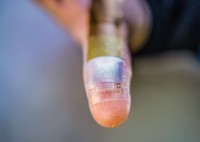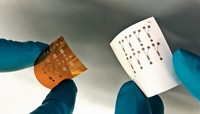Advertisement
Grab your lab coat. Let's get started
Welcome!
Welcome!
Create an account below to get 6 C&EN articles per month, receive newsletters and more - all free.
It seems this is your first time logging in online. Please enter the following information to continue.
As an ACS member you automatically get access to this site. All we need is few more details to create your reading experience.
Not you? Sign in with a different account.
Not you? Sign in with a different account.
ERROR 1
ERROR 1
ERROR 2
ERROR 2
ERROR 2
ERROR 2
ERROR 2
Password and Confirm password must match.
If you have an ACS member number, please enter it here so we can link this account to your membership. (optional)
ERROR 2
ACS values your privacy. By submitting your information, you are gaining access to C&EN and subscribing to our weekly newsletter. We use the information you provide to make your reading experience better, and we will never sell your data to third party members.
Materials
Carbon Nanotube Transistors Could Help Displays Flex
Electronics: Researchers use a springy ion gel to help carbon nanotube transistors stretch further than previous devices
by Katherine Bourzac
January 15, 2014

To make future displays that roll, bend, and stretch, electronics makers need the circuits that control the pixels to be elastic. In particular, they need flexible transistors. Now researchers have built super stretchy transistors from carbon nanotubes (Nano Lett. 2014, DOI: 10.1021/nl403941a).
Michael S. Arnold, a materials scientist at the University of Wisconsin, Madison, thinks carbon nanotubes have amazing properties that make them ideally suited for elastic electronics. “They are some of the best conductors of charge ever discovered—much faster than silicon or organic electronics,” he says. They’re also chemically and mechanically robust: The nanomaterials don’t oxidize when exposed to air, and meshes of the nanotubes can stretch, fold, and withstand tremendous strain without damage.
Given this great stretchiness and conductivity, companies are already looking into using these materials to make flexible electrodes for touchscreens. Making stretchable transistors is harder, Arnold says. Transistors have more parts, and all of them have to stretch in unison. If they cannot move in sync, electrical contacts break, and the transistor can no longer switch on and off.
One particularly tricky transistor part is the dielectric, an insulating material that’s usually made out of unyielding inorganic oxides. The dielectric layer helps ensure that a transistor doesn’t leak current when it is in its off state. It basically ensures the transistor stays off and doesn’t waste power. Feng Xu, a researcher in Arnold’s lab, had the idea to use an ion gel—a squishy polymer embedded with ions—as the dielectric. Ion gels have been used in carbon nanotube transistors before (Nano Lett. 2013, DOI: 10.1021/nl3038773). That previous work took advantage of the gels’ compatibility with printing-based fabrication methods, not their ability to stretch.
To make the stretchy transistors, the researchers first constructed a nanotube mesh by dripping a solution of semiconducting nanotubes onto a glass slide, spreading out the solution, and letting the organic solvent evaporate. Next the team stretched a sheet of clear, rubbery polydimethylsiloxane and pressed it onto the glass slide to pick up the carbon nanotube film. The researchers patterned gold electrodes onto the sheet while it was stretched. They then drop-cast the ion gel onto the nanotube mesh surface.
When the team let the rubber substrate relax, the nanotubes and the gold electrodes wrinkled and buckled. This pre-stretching enabled the finished devices to expand without breaking when strained, Arnold says.
The Wisconsin researchers put their stretchy transistors through electrical and mechanical tests. The devices had a high electron mobility, a measure of how fast electrons can move through the transistor, and a large on-off ratio, a measure of the difference in conductance between its on and off states. To test the devices’ physical resilience, the scientists pulled the transistors sitting on polydimethylsiloxane so that the devices were 57% longer than their resting length. After more than 1,000 pulls, the transistors showed no signs of degradation in electrical performance. The previous record for carbon nanotube transistors was a 20% stretch (Nat. Mater. 2013, DOI: 10.1038/nmat3572).
The devices exhibit good stretchiness, says Young Hee Lee, a researcher at Sungkyunkwan University, in South Korea, who developed the previous record-holding stretchy transistors. But he says the devices still need improvements before they are ready for commercialization. For example, transistor arrays for commercial organic light-emitting diode (OLED) displays will need to switch on and off faster than the devices reported, Lee says.
Arnold is continuing to develop his team’s transistors for use with OLED displays. He wants to incorporate a more elastic dielectric that better matches the other ingredients—it’s the ion gel that breaks down when it’s stretched past 57%, not the electrodes or the nanotubes.





Join the conversation
Contact the reporter
Submit a Letter to the Editor for publication
Engage with us on Twitter